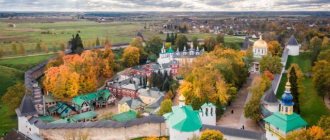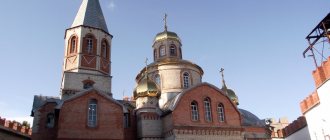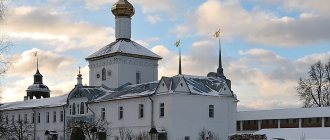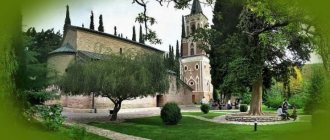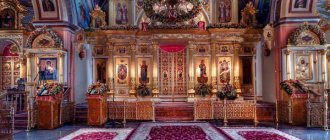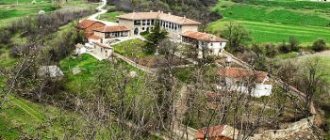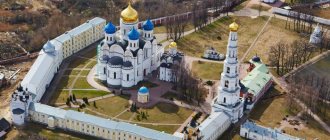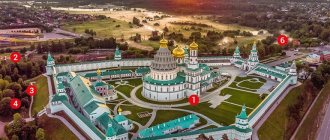Bodbe Monastery or St. Nino in Georgia (Bodbe Monastery of St. Nino, Kakheti, Georgia), located near the city of Sighnaghi in Kakheti, attracts pilgrims from all over the country and the world. After all, it is here that the relics of Nino, who brought Christianity to these lands, the patroness and educator of Georgia, rest. The territory of the monastery deserves special attention - well-groomed green alleys, from which the Alazani Valley is visible, and mountains with snow-capped tops are visible.
Saint Nina
Saint Nina was born into a wealthy family in Cappadocia (present-day Turkish territory). At the age of 12, the girl was given to be raised by a Christian woman serving at the Church of the Holy Sepulchre. She said that the Robe of the Lord was transferred to Iveria (modern Georgia). Two years later, the Mother of God appeared to Nina in a dream, and she told about the election of a girl to search for the Robe and preach the Word of God in that region.
Nino managed to heal the Georgian Queen Nana and King Mirian, her husband, with the help of prayers, after which the ruler accepted Christ. A few years later, in 324, Georgia became Orthodox. The saint went to Kakheti and arrived in the village of Bodbe, where she lived in a tent for several years and converted the Georgians living in the surrounding area to the Christian faith. She died around 335, having bequeathed to bury her in Bodbe, which was done. On the site of her tent in the 50s of the 4th century. They erected a temple (which has not survived to our times), which later grew into a monastery.
According to legend, King Mirian intended to move the relics of the deceased Nino from Bodbe to the Svetitskhoveli Temple in Mtskheta, but two hundred people were unable to move them.
My tourist review
It is clear that the Bodbe Monastery has come a very long way in restoration and now it is pleasant to be in it. The entire territory has been inspected and well-groomed, the buildings are strong and not falling apart, and most importantly, all this does not look like a cheap remake that was needed only in order to use the money allocated by the state, it is clear that they did it primarily for themselves, and therefore soundly and in mind.
My wife and I liked it there, all these trimmed lawns, fir trees, the lack of kitsch - all this was in great contrast with the “home” churches. You could calmly walk along the paths, and no woman at the temple would shush you or look at you from under her brows because you didn’t buy a candle. There are a lot of really young novices there and they don’t hide from tourists, they behave absolutely calm and friendly.
I would love to return here to see what the finished ensemble will look like when the Church of St. Nino.
History of the monastery
The rulers of the royal dynasties always revered this place and showed special concern for its well-being and prosperity. Over time, cultural and religious influences made Bodbe Monastery the center of the Diocese of Bodbe.
Bodbe's heyday was in the 15th century. The monastery became the place of coronation of the Kakheti kings. Afterwards he experienced many different events:
- In the 17th century the Bodbe monastery was destroyed by the Persian ruler Abbas; King Teimuraz I, who restored it, opened a seminary here. The largest number of books on religious topics in Georgia was kept within its walls.
- In the 18th century The monastery of St. Nino became a men's monastery.
- In 1811, after Georgia became part of the Russian Empire, the diocese was abolished, the lands were confiscated, and the place became empty.
- In 1889, Emperor Alexander III, who visited here, was so fascinated by Bodbe that he ordered the restoration of the religious center. The monastery became a women's monastery, and lands were again allocated to it. The buildings of Bodbe were restored, a school of handicrafts and an art school were opened. The first nuns, 12 in number, came here from different parts of Russia. Subsequently, there were about 300 ministers in Bodbe.
- In 1924, the Bolsheviks, who came to power, closed the shrine, abolishing services and destroying buildings, including breaking the cathedral dome. The monastery was abandoned until 1991, when it began to be revived again.
- In 1995 it was decided to renovate the monastery. At this time, archaeological excavations began on the territory of Bodbe, which continue to this day and have revealed valuable relics and parts of ancient buildings.
From 1924 to 1991 There was a hospital in the Bodbe Monastery. One of the most revered icons in Georgia, the Iveron Mother of God icon, was used as a table on which operations took place, as evidenced by the scalpel marks left on it.
Monastery territory
The Monastery of St. Nino in Georgia occupies a large area. The territory contains the main buildings and a well-kept park with plenty of vegetation and paved paths. A small fence has been built around the perimeter; the entrance to the monastery closes at 19.00.
There is a parking lot in front of the Bodbe Monastery. Nearby there is a cafe “Pilgrim”, where you can order national dishes prepared according to monastery recipes. According to local rules, meat dishes are not served here, and alcohol is prohibited. The proceeds go to the needs of the religious complex.
The temple, originally built on the site of St. Nina’s tent, has not survived in Bodbe. In its place in the 9th century. erected a cathedral in the name of St. George the Victorious and Equal-to-the-Apostles Nina. This is the main attraction of the complex, in the southern limit of which the relics of the Saint are located. The building is a brick classical basilica. Here is the icon of the Iveron Mother of God, exuding myrrh, and the remains of the military leader Vasily Gulyakov. The general, a hero of the Caucasian war, is famous for winning the battle with the Dagestanis near the Iori River in 1803.
Behind the Church of St. George in Bodbe there is an observation deck. From here you can admire the picturesque views from above. From here begins the descent to the source of St. Nina with healing water - the second most important attraction of the Bodbe Monastery.
Also on site are:
- Bell tower of the 19th century.
- Church shop.
- Residence of the Patriarch.
- Nuns' cells.
- Cemetery.
- Outbuildings.
Moscow temple of the Georgian enlightener Nino, or Saints have no territorial boundaries
A small wooden church in a residential area of Moscow, opposite the entrance to the Institute of World Economy and International Relations of the Russian Academy of Sciences. Weekday, uncrowded and calm. From the glass cafe located on the church grounds they look with curiosity: should I come in for coffee? I'll definitely come back, but a little later. In the meantime, I open the heavy wooden door of the temple and leave behind it the noise of cars, the gray sky and the chilly Moscow winter...
photo: courtesy of Church of the Holy Equal to the Apostles Nino
Moscow Church of St. Nino Equal to the Apostles
"Rejoice!"
The idea to build a temple in Moscow in honor of the Georgian enlightener arose back in 2004: then a group of proactive Georgians even registered a parish, but 10 years later it turned out that there was one on paper, but not in reality. The recently ordained priest Vladimir Laskin was entrusted with correcting the situation in the Patriarchate of the Russian Orthodox Church.
photo: courtesy of Alexandra Obolonikova
Moscow Church of St. Nino Equal to the Apostles
“There were a lot of difficulties,” he says. — The land is not registered, there are a lot of financial issues, I have no experience in such matters and I don’t have a parish yet either. And those who originally wanted to build this temple no longer have time: the political situation has changed, many have dispersed to other countries, I managed to find only one person from them. Everything was uncertain. And my wife and I, along with several close friends, decided in 2014 to go to Georgia, to St. Nina, to pray.
The company traveled around Georgia for seven days and, of course, visited the Bodbe Monastery, where the relics of the Georgian enlightener rest.
photo: courtesy of Church of the Holy Equal to the Apostles Nino
Moscow Church of St. Nino Equal to the Apostles
“I knew something about it, I studied at the seminary,” recalls Father Vladimir, “but there, in Georgia, I was surprised how the Georgians, through the centuries, despite all the difficulties that befell this people at different times, carried their identity and faith, and a young girl inspired them with her feat. This is very touching! The way she spoke about faith, how purely she conveyed it so that the Georgian people would recognize Christ and love Him, is impressive.
photo: courtesy of Church of the Holy Equal to the Apostles Nino
Moscow Church of St. Nino Equal to the Apostles
After the trip to Georgia, the situation in Moscow began to change. Slowly people began to gather around the yet unbuilt church. A log church was cut down in the Arkhangelsk region, but one thing or another prevented it from being brought to Moscow.
photo: courtesy of Church of the Holy Equal to the Apostles Nino
Moscow Church of St. Nino Equal to the Apostles
“I remember,” says the priest, “on the day of Equal-to-the-Apostles Nina, January 27, 2015, we gathered here, sang an akathist and drank tea - and suddenly the bell rang: “Your logs are coming, rejoice!”
The most Georgian Russian temple
“Much was done by the parishioners themselves,” says Father Vladimir, pointing to the neat wooden walls. “There’s a lot of manual work here, so we did it a little bit at a time.” My believing friends came, invited their acquaintances, some even invited colleagues from work: we’ll sand, paint, clean... We gathered in the evenings, and sometimes left at one o’clock in the morning.
photo: courtesy of Church of the Holy Equal to the Apostles Nino
Moscow Church of St. Nino Equal to the Apostles
There were also those who came and said: “The temple is not needed, we have parking here!” But now the former dissatisfied people got used to it, came to help and admitted that they liked the temple. And then Father Vladimir was forced to patiently explain: “We didn’t choose this land, the city allowed it. There is a hill here, the drop is 9 meters, no one else will build anything here,” and think about what to do with this difficult site.
photo: courtesy of Church of the Holy Equal to the Apostles Nino
Moscow Church of St. Nino Equal to the Apostles
“Just to level the site,” he says now, “600 cubic meters of earth were needed.” And it wasn’t just that he snapped his fingers and everything was covered, it was all carried around and rolled away. And then a real miracle happened: we had asphalt. This is a lot of money—exorbitant for us! Here we walked knee-deep in mud, we could only enter the temple through one door - it was impossible to get to the other. But a merciful person was found: the equipment arrived and for Easter they gave us such a gift - they laid asphalt. And all I know about him is just his name - Boris.
photo: courtesy of Church of the Holy Equal to the Apostles Nino
Moscow Church of St. Nino Equal to the Apostles
In 2021, on Palm Sunday, the church was consecrated, and normal parish life began - with Liturgies, general tea parties after them and Sunday school.
Father Vladimir shows the icons: here is Saint Nino - brought from that first trip to Georgia, and here is Archimandrite Gabriel (Urgebadze), already beloved by many in Russia, and a particle of relics, here is Queen Tamara - the “great woman”, Venerable David of Gareji, Georgian icon of the Mother of God ... In the corner is an exact copy of the Cross of St. Nina.
“I thought the cross she walked with was small,” admits Father Vladimir. - And he is one meter and two centimeters. A Georgian master made this copy for us, attached it to the same Nino cross, which is kept in Tbilisi, in the Zion Cathedral, and then sent it.
photo: courtesy of Church of the Holy Equal to the Apostles Nino
Moscow Church of St. Nino Equal to the Apostles
It seems that Father Vladimir can talk endlessly. Almost each one has its own story about how this or that icon got into the temple. About books, lovingly and carefully selected for a small church shop in the narthex: these ones about St. Nina cannot be found anywhere else in Moscow, they are sent from Tbilisi. About small copies of the holy cross - these are sold in many Georgian churches, and they are also brought here from Georgia. The fact that the choir, despite the fact that the service is in Russian, sometimes sings litanies in Georgian...
photo: courtesy of Church of the Holy Equal to the Apostles Nino
Moscow Church of St. Nino Equal to the Apostles
Today among the parishioners there are both Russians and Georgians. Georgians regularly come here to be baptized or make their first confession. When entering, many say: “It’s like being in Georgia.”
Two hundred Nin and Seraphim of Sarov
— In Russia this is a very common name, only in our church there are several who work, and only one is Georgian. Last year, on January 27, about two hundred Nings came to the service. We prepared 150 small bouquets for the birthday girls and there were not enough of them.
And last year,” the priest continues, “two married couples came to baptize their children on the holiday. I say: “Today it won’t work - there are a lot of people, the bishop is serving, people are walking back and forth... Let’s do it another time.” Some people tell me: “We understand everything, but we didn’t have children for nine years, and then we went to Georgia, prayed to Nina, plunged into the spring, and our daughter was born.” Well, I think we need to baptize.
photo: courtesy of Church of the Holy Equal to the Apostles Nino
Moscow Church of St. Nino Equal to the Apostles
And the second couple: “We also came to you today from the other end of Moscow for a reason! We didn’t have children for four years, we also turned to St. Nina. And we feel that our daughter was born through her prayers.” I had to baptize on such a difficult day, but I did it with great joy! You see, saints have no territorial boundaries. They have spiritual boundaries, but if the human heart responds, then the saints will be nearby.
photo: courtesy of Alexandra Obolonikova
Moscow Church of St. Nino Equal to the Apostles
Many Georgian saints are loved in Russia, and many Russian saints are loved in Georgia.
“Whoever we have been to at home in Georgia always has an icon of St. Seraphim of Sarov, he is very revered there. It seems to me that, if possible, every tenth person from there would go to Russia on a pilgrimage to the saint. Recently, one of our parishioners comes up to me and tells me how he was in a monastery near Moscow, which was founded by a mother from Georgia and shows a small icon. And I say: yes, I know, this is Mother Tamar (Marjanishvili), the founder of the Seraphim-Znamensky monastery. Here we have an icon of her with a piece of her relics. And he told me: “I didn’t know!”
photo: courtesy of Church of the Holy Equal to the Apostles Nino
Moscow Church of St. Nino Equal to the Apostles
Over the centuries, the two cultures have become tightly intertwined and now do not lose touch, continuing to discover each other. But there is something in them that was and will be one, says Father Vladimir:
- For them, Christ is a value, and for us.
Mrevli
The Church of St. Nina in Cheryomushki becomes a kind of center for communication between two peoples: not only through joint prayer, but through holidays and cultural events, conversations over tea or coffee after the service. Especially for this purpose, a small café-reading room called “Mrevli”, which is translated from Georgian as church parish, parishioners, flock, was set up on the territory with just a few tables.
photo: courtesy of Church of the Holy Equal to the Apostles Nino
Moscow Church of St. Nino Equal to the Apostles
“In my initial understanding,” explains Father Vladimir, “this is a place where people can socialize after the service. You can also come here with non-church people, because you can’t bring everyone to church at once: you can sit here, drink coffee, and then go to church. This is a buffer zone. There is no income from it yet, but people like it.
photo: courtesy of Church of the Holy Equal to the Apostles Nino
Moscow Church of St. Nino Equal to the Apostles
On weekdays there are only rare regulars. Anya, a cafe employee and parishioner of the temple, brews coffee on the sand (this is an option for those who are not in a hurry; for those in a hurry, there is a coffee machine) and tells how one girl went for a walk during her lunch break and always came in for five minutes - to exchange a few phrases and take favorite drink, and when I changed jobs, I came in to say goodbye.
photo: courtesy of Alexandra Obolonikova
Moscow Church of St. Nino Equal to the Apostles
Anya shows the assortment: on weekdays it is limited, on weekends it is more varied. Baking is prepared in the temple refectory. Georgian eclairs shu are especially popular among children after Sunday services. More from Georgian: lemonade and spices; Churchkhela, brought from Georgia, has now run out.
photo: courtesy of Alexandra Obolonikova
Moscow Church of St. Nino Equal to the Apostles
“There’s no one during the week, but on weekends people will crowd here - noise, din.” They just don’t smoke,” Father Vladimir and Anya laugh, remembering the familiar atmosphere of many Georgian cafes.
And now you can calmly read a book. The library is small - there is not enough space, and, unlike coffee, they do not give books to take away, but in order not to forget where you stopped, you can leave a personalized bookmark.
photo: courtesy of Alexandra Obolonikova
Moscow Church of St. Nino Equal to the Apostles
Everything here feels like home. But now the parish faces a global task: to build a large stone church. The cozy wooden one becomes cramped. But even after the expansion, they hope to maintain a sense of community, which parishioners often lack in large city churches.
photo: courtesy of Church of the Holy Equal to the Apostles Nino
Moscow Church of St. Nino Equal to the Apostles
“The project is being prepared, there is a place,” Father Vladimir points to the slope behind the church. “We’ve already figured out how we’ll arrange it.” The upper church will be in honor of St. Nina, the lower one we would like to consecrate in honor of Elder Gabriel (Urgebadze), and the current wooden one will become Sergius of Radonezh and his parents, Saints Cyril and Mary. The result will be a whole complex with additional spaces for joint activities and communication. This is a serious, big deal, and so far we do not have enough internal strength and resources. But when we started building this temple, we also had nothing: neither money, nor so many friends. Now there are more of us, Georgians are joining us, and, if God wills it, there will be a large stone temple.
photo: courtesy of Church of the Holy Equal to the Apostles Nino
Moscow Church of St. Nino Equal to the Apostles
The Church of St. Nina Equal to the Apostles in Cheryomushki is open daily from 08:00 to 20:00. Liturgies are celebrated on Sundays and holidays. On Fridays at 18:00 – prayer service to St. Nino. The schedule of services and church news is on the official website of the parish.
The cafe-reading room “Mrevli” is open daily from 10:00.
Address: Moscow, st. Profsoyuznaya, ow. 21/23. Three minutes from Profsoyuznaya metro station.
St. Nina's Source
The spring is located in the gorge, below the monastery, and can be reached either by car along a mountain road or on foot. A winding staircase leading through the forest leads to it. The distance to the spring is considerable - about three kilometers, and if the descent to the spring is not difficult, then not everyone can do the difficult climb. In this case, taxi drivers are on duty at the source.
Below there is a small church in the name of Nino's parents Zabulon and Sosanna and a bathhouse. In order to take a dip, you will need a shirt (tunic), you can buy it right there. There are always a lot of people at the spring - everyone wants to be healed and get holy water.
Prayers and troparion
The troparion is written in the fourth tone, the kontakion in the second. In the text, Nina is called “most praiseworthy,” equal to Saint Andrew and the other apostles. The troparion and kontakion are read or sung for the purpose of glorification on the days of remembrance, which the Orthodox Church celebrates on January 14 and October 1.
There are two prayers written to Saint Nina Equal to the Apostles, they can be read at any time, they ask a Christian to protect him from troubles and misfortunes, to save the Orthodox Church from schisms and heresies, and also to ask God for the Kingdom of Heaven for the believer after death.
How to get there
The distance between Tbilisi and Bodbe is 110 km. The first and easiest way to get to the monastery is to take a tour (they depart daily from Tbilisi and other major cities), visiting other interesting places in Kakheti along the way. You can also use taxi services. Travel time will be about 2 hours.
The Monastery of St. Nino, Bodbe is located just 2 km from Sighnaghi; minibuses go to the city from Tbilisi. The distance from Sighnaghi to the monastery can be covered by hitching a ride or walking.
Helpful information
- GPS coordinates for Navitel: N 41°36'23", E 45°55'58"
- Coordinates for YandexMaps and Google Maps: 41.606302, 45.932683
- Coordinates of the healing spring: N 41°36'33", E 45°56'14"
- The entrance is free.
- Opening hours: from 10:00 to 19:00.
How to get there
If you are going to Bodbe, then it is better to do it in conjunction with a tour of Sighnaghi and the Alazani Valley in principle. It takes the whole day, includes wine tasting, chacha, visiting all sorts of interesting places and is deservedly one of the most popular excursions from Tbilisi. I only advise you to book excursion tours in advance, otherwise during the season the cheapest offers with good guides are quickly sold out.
If you drive on your own, then buy a ticket for the Tbilisi-Sighnaghi minibus for 6 GEL, departing from the Samgori metro station, and ask the driver to stop at the turn to Bodbe. The fact is that this turn is very sharp and it’s easy to skip it; if this happens, you’ll have to walk ~2 km in the opposite direction. But on foot you are unlikely to miss the sign. Minibus schedule:
- Tbilisi-Sighnaghi 9-00, 11-00, 13-00, 15-00, 17-00, 18-00.
- Sighnaghi-Tbilisi 7-00, 9-00, 11-00, 13-00, 16-00, 18-00.
By car everything is the same as with a minibus. Keep in mind that the distance from Tbilisi to Sighnaghi is 110 km, which will take 2-2.5 hours one way. Therefore, leave early, otherwise you won’t have time to inspect everything, because... the gates will be closed and no one will be able to pass through.
If everything is done on time, then one day will be enough to do everything.
